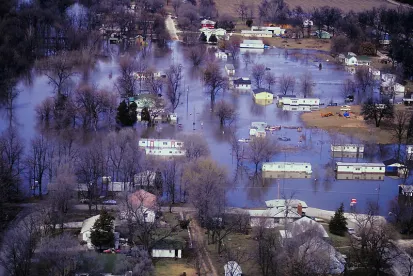Residents of Houston, Texas held their breath once again on September 17, 2019, as Tropical Storm Imelda made landfall. The storm inundated the city with 43 inches of rain, making it the fourth-wettest tropical cyclone in the history of Texas and the fifth-wettest in the history of the continental United States.
The Texas National Guard rescued hundreds of people from communities throughout the Houston area, and hundreds of others were stranded in their vehicles as the record-breaking flood waters rapidly rose.
Still, Imelda pales in comparison to the highest-ranking storm to hit Texas, Hurricane Harvey, which struck in August 2017. Although the scale of Harvey’s damage was perhaps unexpected, one likely could have predicted in early 2017 that at least some portion of the Gulf Coast would be struck by a hurricane that year. The reality is that constructing in Texas, Louisiana, Mississippi, Alabama, or Florida in July, August, or September carries with it the very real risk that your construction site will be struck by a hurricane or tropical storm. The 2017 Atlantic hurricane season saw 17 named storms, with more than $200 billion in damages. Three of those named storms—Harvey, Irma, and Maria—made the 2017 Atlantic hurricane season the costliest ever on record.
Of course, thankfully, not every year will be a record-setter like 2017 and 2019. But constructing along the Gulf Coast or any other “disaster-prone” area carries with it unique considerations. Construction contracts almost universally include “force majeure” provisions that apply in the event of a hurricane, but force majeure provisions typically only buy the contractor some time. Moreover, such provisions are breeding grounds for disputes. For example, most force majeure clauses include hurricanes as qualifying events, but recall that “Hurricane” Harvey did most of its damage as a tropical storm. “Tropical storm” may not be included in the force majeure definition in your contract. Second, most contracts will require timely “notice” of the qualifying event, which can be difficult when you are in the midst of disaster recovery. Third, contracts and case law will often require a demonstration that the contractor acted to mitigate the effect of the force majeure event. See also In re S. Scrap Material Co., L.L.C., 713 F. Supp. 2d 568 (E.D. La. 2010) (noting that Hurricane Katrina was an “Act of God” but “[o]ne invoking Act of God as a defense must prove not only that the weather was heavy but also that it ‘took reasonable precautions under the circumstances as known or reasonably to be anticipated.’”). That sounds reasonable, but mitigation efforts at the height of a disaster are often criticized after the fact, when time and circumstance allow for analysis and reflection. Finally, the contractor must be able to show that the force majeure event caused the delay at issue. Often, however, the contractor is moving so quickly—as are the sub-contractors, suppliers, laborers, insurance companies, etc.—to deal with the disaster at hand that detailed meeting minutes, confirming emails, and contemporaneous reports are simply not able to document all the ways the force majeure event is affecting the time line of the construction project.
Contractors along the Gulf Coast cannot simply hope for the best when constructing during hurricane season. Nor can they expect to rely on insurance and force majeure provisions should the worst happen. Instead, contractors should be fully prepared with a disaster action and recovery plan before signing a contract. Indeed, owners in the Gulf Coast region—particularly in populated, industrial, burgeoning cities like Houston, and particularly following storms like Harvey and Imelda—are coming to expect their contractors on major projects to have detailed and thorough disaster contingency plans in place.
What’s in Your Disaster Action Plan?
Your disaster preparedness and recovery action plan depends on the disaster and the construction project. It should cover pre-construction disaster planning, such as identifying roles and responsibilities in the event of a disaster, identifying potential off-site quarters in the event of a local evacuation order, and creating an emergency call list, among other items. This stage—i.e., before a storm is barreling down on your project—is a good time to consider potential labor and supply shortages that typically result after hurricanes. For example, demand for construction supplies and services skyrocketed after Hurricane Harvey. Thomasnet.com, an online sourcing and supplier selection platform, analyzed searches for particular products and supplies before and after Harvey. The below tables summarize some of the results, including a 1,200 percent increase in searches for doors, a 1,700 percent increase in searches for steel buildings, and a 4,600 percent increase in searches for trucking services. See https://blog.thomasnet.com/thomasnet-trends-hurricane-harvey.
Likewise, although not on the same scale as Harvey, Imelda is sure to bring similar increases in Houston as a result of the citywide flooding, given the significant damage to hundreds of homes and other buildings.
Identifying potential suppliers, labor sources, and transportation that may be available to you ahead of time could make a huge difference in your recovery and your bottom line. Remember that most force majeure clauses will not allow you to recover increased costs if the cost of materials suddenly surges after the storm. See, e.g., S&B/Bibb Hines Pb3 Joint Venture v. Progress Energy Fla., Inc., 365 Fed. Appx. 202 (11th Cir. 2010) (denying contractor’s $40 million claim after four hurricanes struck the Gulf Coast, resulting in a shortage of materials and a corresponding increase in the costs of construction for the contractor). If you are a large contractor, consider whether you have projects in other locations that could spare materials at cost until prices come down. Alternatively, consider mitigating the risk through agreements with construction companies in other locations that may be willing to “come to your aid” should you be impacted (knowing that, as part of the risk-sharing arrangement, you would be willing to reciprocate).
Your disaster action plan should also cover what to do when a storm has been predicted, when it is occurring, and after it has passed. There is plenty of hurricane-preparedness advice out there, but one source we like as a starting point is Allianz’s The Calm Before the Storm: Construction Site Hurricane Protection. This 33-page booklet, available online, includes useful information, suggestions, checklists, and forms for contractors working in hurricane-prone areas.
The point is this: as hurricane season continues along the Gulf Coast, do not be lulled into a false sense of security that (1) a storm probably won’t happen or (2) a force majeure or similar contract provision will provide adequate protection. On the Gulf Coast, hurricanes and tropical storms are a fact of life, and force majeure provisions are better left as a last resort.






 />i
/>i


